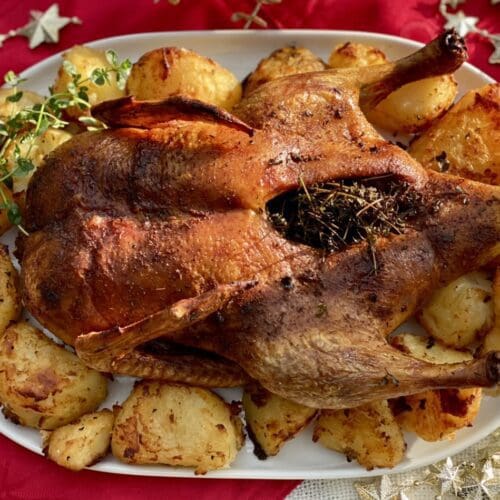
Roast Duck (Easy, tender with crispy skin)
No scoring, twining, basting & fidgeting with the oven! This easy roast duck is going to give you the most crispy skin & tasty, tender duck
Video
Ingredients
- 2.3 to 2.5kg / 5 to 5.5lb whole duck (NOTE 1)
- 2 tsp smoked paprika
- 2 tsp garlic powder
- 1 tsp dried thyme
- 2 tsp salt
- 1 tsp fresh ground pepper
- optional - small bunch of fresh thyme or small onion for cavity
For the duck fat potatoes (optional)
- 1.2kg / 2.6lb large potatoes (peeled and cut into 4 or 6 pieces) (NOTE 2)
- 1 tbsp salt (for boiling with the potatoes)
- 1 tbsp semolina (NOTE 3)
- ½ tsp salt
Instructions
- For the dry herb rub - In a small bowl, mix the smoked paprika, garlic powder, dried thyme, salt and pepper until combined.
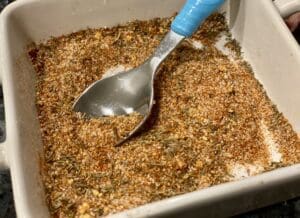
- Use paper towels to pat the duck dry all over, including inside of its cavity. Rub the combined herbs evenly over the duck, including the cavity. Put the duck on a roasting rack and place it in a roasting tray. Chill the duck uncovered in the fridge for 24 to 48 hours. This method will dry out the duck and give it a deliciously crispy, golden skin when roasted.
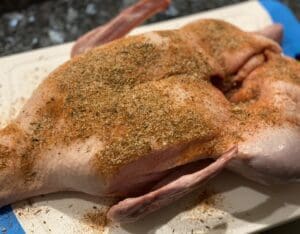
- Take the duck out of the fridge and allow it to rest at room temperature for 30 to 60 minutes (depending on the ambient temperature) before roasting. Doing this helps the duck cook evenly.Preheat oven to 210°C (410°F) or 190°C (374°F) for fan-forced ovens. To make cleaning easier, line the baking tray with baking/parchment paper, then line the entire inside of the tray with foil. If roasting potatoes with the duck - Ensure the foil is lined carefully, especially at the base, to catch the fat drippings, you don't want the fat to seep under the foil.
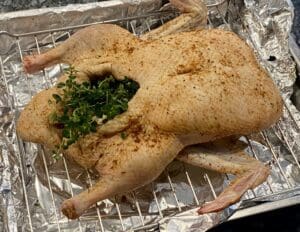
- To prevent the herbs from burning, remove them from the duck with paper towels. Insert the onion and thyme in the cavity. Put the duck and its roasting rack on the foil-lined roasting tray. Roast the duck for 1 hour and 40 minutes our until cooked. Allow the duck to rest for 30 minutes before carving.

- For the duck fat potatoes (optional) - As soon as the duck is in the oven, start on the potatoes. Transfer the potatoes into a saucepan along with 1 tbsp of salt, then add enough water to submerge the potatoes by at least 4cm / 1.6in. Bring water to a boil over high heat, then reduce the heat to medium and continue to boil the potatoes for 10 minutes.
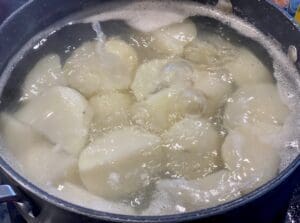
- Drain the potatoes in a colander and let them sit for 5 minutes to allow the steam to dry them. Return the potatoes to the same saucepan along with the semolina and 1/2 tsp of salt. Cover the saucepan and give it 4-5 shakes to roughen the potato surface.

- Remove the duck from the oven after 40 minutes. Lift the roasting rack with the duck away from the roasting tray, being cautious and using mittens. There should already be some duck fat drippings on the foil. Cover the potatoes with the fat, then place the rack and duck back on top. Put the tray back in the oven.Turn the potatoes every 30 minutes so they'll brown and crisp evenly. The duck will finish roasting before the potatoes. When the duck is out of the oven and resting, increase the oven temperature to 230°C (450°F) or 210°C (410°F) for fan-forced ovens. Roast the potatoes until they are golden brown and crispy

Notes
Dry herb rub - I used garlic powder, thyme and smoked paprika, but you could substitute with any of your favourite dried herbs and spices.
(NOTE 1) Whole duck - My duck came frozen, weighing 2.3 kg / 5lb, but anything between 2.3 to 2.5kg / 5 to 5.5lb is fine. I defrosted my duck in the fridge for a couple of days.
(NOTE 2) Potatoes - I used cheap all-rounder large white brushed potatoes. Starchy or all-rounder potatoes work best (not waxy potatoes). Desiree, Sebago, Dutch Cream, Maris Piper, or Russet potatoes are excellent choices.
(NOTE 3) Semolina is a coarse flour that comes from durum wheat, the same wheat that is used to make pasta and couscous. Semolina makes the crust on the potatoes extra crunchy. You can usually find semolina in the same aisle as the flour or health foods. You can use cornflour or cornstarch instead of semolina.
Leftovers should be stored in an airtight container in the fridge for up to three days. The duck fat potatoes are most delicious when served right away, although they can also be stored for a few days.
I've used a third-party application to calculate the calories and nutritional information, so please use this as an approximate guide only.
Cooking measurements are in Australian standard spoon and cup measurements. For specific details and conversions, visit our Australian Cooking Measurements page.
Nutrition
Serving: 1servingCalories: 1298kcalCarbohydrates: 1gProtein: 44gFat: 151gSaturated Fat: 51gPolyunsaturated Fat: 20gMonounsaturated Fat: 72gCholesterol: 291mgSodium: 1018mgPotassium: 834mgFiber: 0.5gSugar: 0.1gVitamin A: 981IUVitamin C: 11mgCalcium: 50mgIron: 10mg